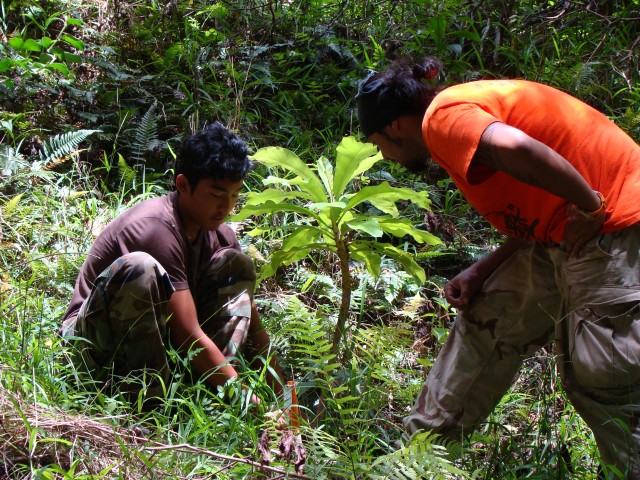<p> MAKUA, Hawaii - In the last morning hours, July 18, in the fern-filled gully of Kahahaiki, the northern most gulch of valley here, strange sounds could be heard echoing off the valley walls.</p><p>"Height: 2.15 meters." <br> "Basal diameter: 23 centimeters." <br> "Vigor: healthy." <br> "Where's plant number 75'" </p><p>These were the shouts of 10 dedicated interns and their two leaders from the Hawaii Youth Conservation Corps (HYCC), a summer internship program for youth interested in conservation. The interns were calling off measurements to their teammates, who diligently recorded the information. </p><p>The group was assisting staff from the Oahu Army Natural Resource Program (OANRP) in locating and monitoring the endangered Cyanea superba, a native Hawaiian lobelia plant resembling a cabbage on a stick. </p><p>After one day, HYCC interns, working side-by-side with OANRP staff had monitored more than 75 endangered plants, collected more than 150 fruit from a native nettle tree (mamaki), built steps along steep sections of trail, constructed fence crossings, and removed more than 100 invasive plants from the native forest of Kahanahaiki. </p><p>This particular group was now on its fourth day with the OANRP staff, actively engaging in natural resource management. The summer at OANRP has been dubbed "Conservation Camp," an appropriate reference to the multitude of young adults learning about careers in conservation through internships with OANRP. From June through August, OANRP staff will have introduced the many aspects of natural resource field work to nearly 40 interns, including 30 one-week interns, two six-week interns, and three three-month interns. This temporary boost in the number of "field technicians" has enabled OANRP staff to accomplish a number of natural resource management tasks in a very short time frame. </p><p> However, the value of completed work tasks pales in comparison to the long-term benefits of exposing young adults to the important careers in conservation.
'Conservation Camp' interns clean up Makua Valley
By Kimberly Welch, Oahu Army Natural Resource ProgramAugust 5, 2008




Social Sharing